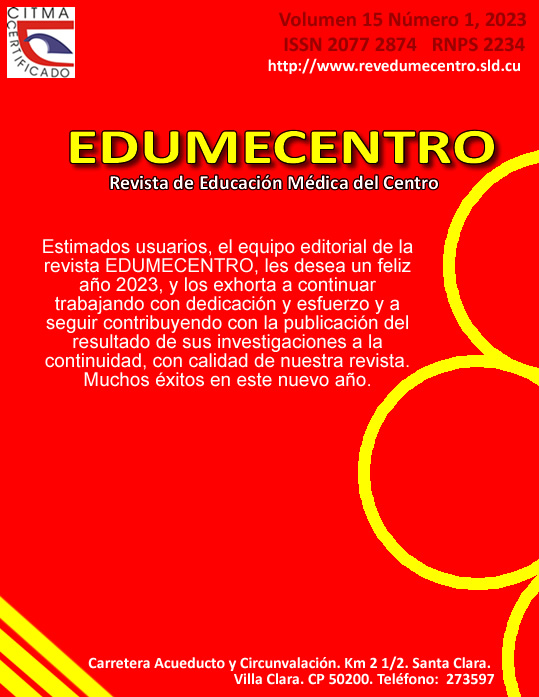Information and Communication Technologies for Logophonoaudiology
Keywords:
speech therapy, audiology, telemedicine, rehabilitation, medical informatics, education, medicalAbstract
Introduction: Information and Communication Technologies, networks, devices, and services facilitate access to health services in less time, cost and greater ubiquity.
Objective: to update essential concepts on the use of Information and Communication Technologies for pre-professional training and care practice in Logophonoaudiology.
Methods: documentary research was carried out in databases: Redalyc, Dialnet, SciELO, Doaj, Latindex, Scopus, Redib, Google Scholar, the World Health Organization website, 25 documents from the period 2019-2022 were selected. Boolean logical computers: AND, OR, were used as search strategies to combine the terms ICT, Logophonoaudiology, Logopedia and concepts related to health sciences.
Development: after the COVID-19 epidemic, the use of networks, devices, and technological services in Speech Therapy, Phoniatrics and Audiology activities was energized. Using telehealth in the training of the Logophonoaudiology Degree makes it easier to organize health education processes and offer these services with the use of technologies.
Conclusions: telemedicine and telehealth are two of the concepts that arise with the application of Information and Communication Technologies in health, tools that facilitate access to health services, promotion, diagnosis, monitoring, and treatment of diseases. In speech therapy, it allows individualized attention, autonomous work, greater feedback between the actors in the process for intervention, treatment, and rehabilitation in a synchronous and asynchronous way.
Downloads
References
1. Cardoso S. Barreras y palancas para el uso de la telerrehabilitación a través de la experimentación en tres países. [Internet]. Dirección de Rehabilitación. Luxemburgo: AID and Development; 2021 [citado 10/01/2023]:[aprox. 67 p.]. Disponible en: https://www.hi.org/sn_uploads/document/barrerasypalencastelerehabilitacion_ie16.pdf
2. Vialart Vidal MN, Vidal Ledo MJ, Pérez Matar R. Empleo de la salud móvil en Cuba para el enfrentamiento a la COVID-19. Rev Cub Salud Publ [Internet]. 2020 [citado 15/03/2023];46(suppl 1):[aprox. 7 p.]. Disponible en: http://scielo.sld.cu/scielo.php?script=sci_arttext&pid=S0864-34662020000500012
3. Stolik Lipszyc O, Chiu García AK. Potencialidades de Cuba para el desarrollo las m-salud. Rev Cub de Econom Internac [Internet]. 2021 [citado 10/01/2023];8(1):[aprox. 26 p.]. Disponible en: https://revistas.uh.cu/rcei/article/view/3010
4. Organización Mundial Salud. La OMS publica las primeras directrices sobre intervenciones de salud digital. [Internet]. 2019 [citado 10/01/2023]. Disponible en: https://www.who.int/es/news/item/17-04-2019-who-releases-first-guideline-on-digital-health-interventions
5. Cala Peguero TY. Tecnologías en educación superior: necesidad e impronta ante la COVID-19. Rev MENDIVE [lnternet]. 2021 [citado 10/01/2023];19(1):[aprox. 5 p.]. Disponible en: https://mendive.upr.edu.cu/index.php/MendiveUPR/article/view/2302/pdf
6. Mansilla Cordeiro EJ. Herramientas de telesalud para el seguimiento posoperatorio de enfermería en servicios de cirugía mayor ambulatoria. Rev Cubana Enfermer [Internet]. 2020 [citado 15/03/2023];36(3):[aprox. 12 p.]. Disponible en: http://scielo.sld.cu/scielo.php?script=sci_arttext&pid=S0864-03192020000300018
7. Curioso Walter H, Galán Rodas E. El rol de la telesalud en la lucha contra el COVID-19 y la evolución del marco normativo peruano. Acta Med Peru [Internet]. 2020 [citado 10/01/2023];37(3):[aprox. 10 p.]. Disponible en: http://www.scielo.org.pe/scielo.php?script=sci_arttext&pid=S1728-591720200003003660
8. Rodríguez Hernández Y, Rodríguez Jiménez GE. Competencia digital en Fonoaudiología retos de formación profesional desde los avances tecnológicos. Rev Logop, Foniatría y Audiología [Internet]. 2019 [citado 10/01/2023];39(4):[aprox. 9 p.]. Disponible en: https://www.sciencedirect.com/science/article/abs/pii/S0214460319300506
9. Organización Mundial de la Salud. Declaración conjunta de la UIT y la OMS: Desencadenar el potencial de la tecnología de la información para derrotar la COVID-19. [Internet]. 2020 [citado 10/01/2023]. Disponible en: https://www.who.int/es/news/item/20-04-2020-itu-who-joint-statement-unleashing-information-technology-to-defeat-covid-19
10. Rodríguez Gómez AM, Cabrera Díaz de Arce I, Caballero Rubiella KM, Solis Solis S, Brito Menédez DI. Desempeño profesional en Logofonoaudiología. Rev Cub Tec Salud [Internet]. 2020 [citado 15/03/2023];11(1):[aprox. 6 p.]. Disponible en: https://revtecnologia.sld.cu/index.php/tec/article/view/1686/1384
11. Campra MC, Isaías AC. Fonoaudiología. Intervenciones y prácticas posibles. [Internet]. Argentina: Fervil Impresos; 2021 [citado 10/01/2023]:[aprox. 151 p.]. Disponible en: https://fcm.unr.edu.ar/wp-content/uploads/2021/03/Fonoaudiologia.-Intervenciones-y-practicas-posibles.-FCM_compressed.pdf
12. Massana C, Figueroa M. Telelogopedia en el contexto de la pandemia de la COVID-19: Análisis de las adaptaciones y las percepciones de los logopedas. Rev Investig Logopedia [Internet]. 2022 [citado 11/01/2023];12(1):[aprox. 16 p.]. Disponible en: https://revistas.ucm.es/index.php/RLOG/article/view/77746/4564456559953
13. Zúñiga Beñaldo E. Telepráctica de la terapia vocal: una reflexión sobre su aplicación a partir del COVID-19. Rev Investig Innov Cienc Salud [Internet]. 2020 [citado 15/03/2023];2(2):[aprox. 13 p.]. Disponible en: http://www.scielo.org.co/scielo.php?script=sci_arttext&pid=S2665-20562020000200070
14. San Martín M, Gutiérrez Y. Teleterapia fonoaudiológica en contexto educativo chileno durante la pandemia por COVID-19. Calidad en la educación [Internet]. 2021 [citado 11/01/2023];(55):[aprox. 22 p.]. 275-296. Disponible en: https://www.scielo.cl/scielo.php?script=sci_arttext&pid=S0718-45652021000200275
15. Rodríguez D, Araya P, Catrifol M, Ferrada R, Ibarra M, Morales C. Uso del smartphone en telepráctica para trastornos de la voz. Una revisión desde el concepto de Mhealth. Rev Investig Logopedia [Internet]. 2022 [citado 16 /03/2023];12(2):[aprox. 10 p.]. Disponible en: https://revistas.ucm.es/index.php/RLOG/article/view/78550/4564456560458
16. Pérez Rodríguez L, del Fresno Justo D. El uso de las TIC en la orientación familiar para el desarrollo del componente fonético-fonológico del lenguaje. Rev de Educac Virtual EduTic Innova [Internet]. 2020[citado 11/01/2023];(8):[aprox. 14 p.]. Disponible en: https://www.aulavirtualusmp.pe/ojs/index.php/eduticinnova/article/view/1908
17. Espada Chavarría RE, Moreno Rodríguez R, Moran Montalvo M. Educación inclusiva y TIC: sistemas de barrido ocular para alumnado con parálisis cerebral en Educación Primaria. ENSAYOS [Internet]. 2020 [citado 11/01/2023];35(2):[aprox. 20 p.]. Disponible en: https://revista.uclm.es/index.php/ensayos/article/view/2551/2002
18. Belloch C. Recursos Tecnológicos (TIC). [Internet]. Universidad de Valencia. España: Unidad de Tecnología Educativa (UTE); 2013 [citado 11/01/2023]:[aprox. 8 p.]. Disponible en: https://www.uv.es/bellochc/logopedia/NRTLogo1.pdf
19. González Rus G. Logopedia escolar digitalizada. [Internet]. España: Ministerio de Educación; 2011 [Internet]. Dirección de Rehabilitación. Luxemburgo: AID and Development; 2021 [citado 10/01/2023]:[aprox. 67 p.]. Disponible en: Disponible en: https://sede.educacion.gob.es/publiventa/PdfServlet?pdf=VP14629.pdf&area=E
20. Hervás Gómez C, Toledo Morales P. Nuevas Tecnologías aplicadas en el ámbito de la Logopedia [Internet]. Universidad de Sevilla: @prende~eia; 2008. [Internet]. Dirección de Rehabilitación. Luxemburgo: AID and Development; 2021 [citado 10/01/2023]:[aprox. 39 p.]. Disponible en: https://www.researchgate.net/publication/322910281_Nuevas_Tecnologias_aplicadas_en_el_ambito_de_la_Logopedia
21. Cuba. Ministerio de Educación Superior. Documento base para el diseño de los planes de estudio “E”. La Habana: MES; 2020.
22. Fernández Silva I, Vásquez Zubizarreta G. Implementación de las TIC en la Formación del maestro logopeda. Rev de la direcc de Informatiz UCPEJV [Internet]. 2022 [citado 17/02/2023];1:[aprox. 9 p.]. Disponible en: http://revistas.ucpejv.edu.cu/index.php/rVid/article/view/1625/2017
23. Rodríguez Gómez AM, Cabrera Díaz de Arce I, Caballero Rubiella KM, Solis Solis S, Brito Menédez DI. Desempeño profesional en Logofonoaudiología. Rev Cub Tec Salud [Internet]. 2020 [citado 16/03/2023];11(1):[aprox. 8 p.]. Disponible en: https://revtecnologia.sld.cu/index.php/tec/article/view/1686/1384
24. Alvarez Arrieta YA, Valcárcel Izquierdo N, Pazo Quintana T, Caballero Rubiella KM, Simón Chibás NB, Suárez Mora JT. Recursos tecnológicos en Logofonoaudiología. Rev Cub Tec Salud [Internet]. 2021 [citado 16/03/2023];12(4):[aprox. 11 p.]. Disponible en: https://revtecnologia.sld.cu/index.php/tec/article/view/2506/1541
25. Lobos Villatoro N, del Campo Rivas M, Silva-Rios A. Dominios de provisión de servicios en fonoaudiología y Atención Primaria de Salud a propósito de la COVID-19: Una revisión narrativa. Rev Chil de Fonoaudiol [Internet]. 2020 [citado 16/03/2023];19:[aprox. 7 p.]. Disponible en: https://revfono.uchile.cl/index.php/RCDF/article/view/60183
Published
How to Cite
Issue
Section
License
Los autores que publican en esta revista están de acuerdo con los siguientes términos:- Los autores/as conservarán sus derechos de autor y ceden a la revista el derecho de primera publicación de su obra, el cuál estará simultáneamente sujeto a una Licencia Creative Commons Reconocimiento-NoComercial-CompartirIgual 4.0 Internacional (CC BY-NC-SA 4.0) que permite a terceros compartir la obra siempre que se indique su autor y su primera publicación esta revista.
- Los autores pueden establecer por separado acuerdos adicionales para la distribución no exclusiva de la versión de la obra publicada en la revista (por ejemplo, situarlo en un repositorio institucional o publicarlo en un libro), con un reconocimiento de su publicación inicial en esta revista.
- Se permite y se anima a los autores a difundir sus trabajos electrónicamente (por ejemplo, en repositorios institucionales o en su propio sitio web) antes y durante el proceso de envío, ya que puede dar lugar a intercambios productivos, así como a una citación más temprana y mayor de los trabajos publicados (Véase The Effect of Open Access) (en inglés).







